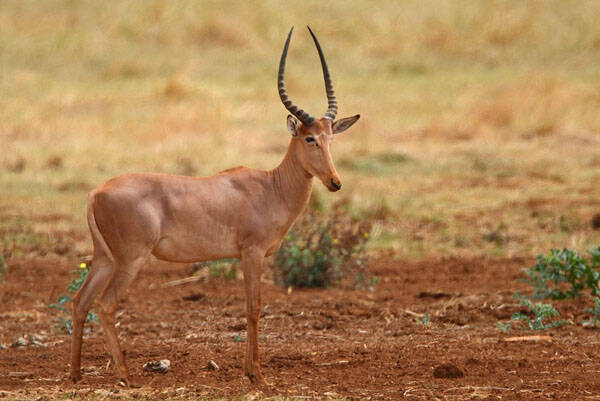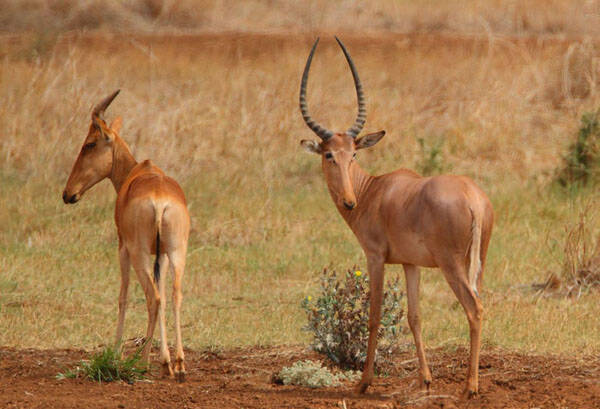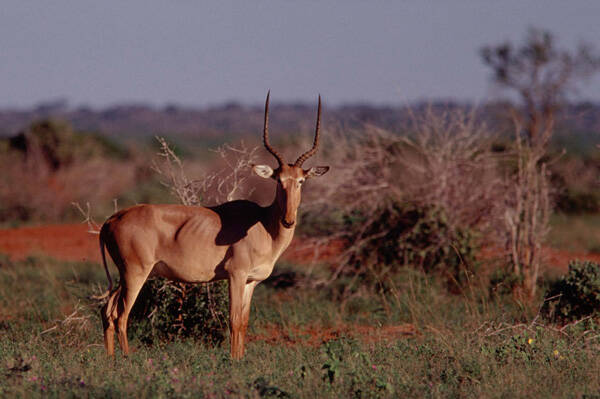Beatragus hunteri
IUCN
LCBasic Information
Scientific classification
- name:Beatragus hunteri
- Scientific Name:Beatragus hunteri,Hirola,Herola,Four-eyed hartebeest
- Outline:Ungulata
- Family:Artiodactyla Bovidae Henselae
Vital signs
- length:120-205cm
- Weight:80-118kg
- lifetime:No verification information
Feature
There is a white frame around the eyes, so it is also called "four-eyed antelope"
Distribution and Habitat
Origin: Kenya; uncertain: Somalia.
The Henson's wildebeest lives in the area between the Tana River in Kenya and the Juba River in Somalia. In 1963, a small group of about 20 individuals was introduced from the South Garissa district into Tsavo East National Park in Kenya.
It inhabits dry acacia scrub or scrub mixed with short grass, seasonally dry grassland and forest savannah and grassland patches. Feeding areas change over time because they become unsuitable due to intrusion by predators or large groups of other species, drought or overgrowth of grass. The maximum range of the Henson's wildebeest is more than 100 square kilometers.
Appearance
The Henson's Wildebeest has a head-body length of 120-205 cm, a shoulder height of 100-125 cm, a tail length of 30-45 mm, and a weight of 80-118 kg. It has long legs, a long body, a slightly protruding forehead, and a short neck. Both sexes have horns, which are distinctive lyre-shaped horns that curve and flare slightly from their base to one-third of their length, with a distinct ring. When fully extended, they reach a length of about 70 cm. The fur of this species is very distinctive, sandy brown in color. There is a white band on the bridge of the nose, and there is an inverted white chevron-shaped strip between its eyes, connecting and surrounding the eyes to form a white eyeglass frame. There is a very thick layer of skin on the nape of the neck, forming a ridge when the ears are folded. The ears are white with black tips. The tail is white. The fur of males is grayer than that of females, while the belly is lighter in color.
Details
Hirola (scientific name: Beatragus hunteri) is also known as Hirola and Herola in foreign languages. There is no subspecies.

Hirola is a species similar to the genus Beatragus and the hartebeest, but they can be distinguished by their horn shape, body shape and fur color. The Henson's wildebeest is lighter than the kudu and hartebeest, and its face is less extreme in length than the hartebeest, with a more rounded occipital region of the skull, making it more similar to species of the genus Kudu. The Henson's wildebeest is less elevated relative to the hindquarters than the kudu and hartebeest. The eye sockets of the Henson's wildebeest are white, while most antelopes, including the kudu and hartebeest, have dark eye sockets. In contrast to the darker fur of these two species, the Henson's wildebeest has a uniform yellow-brown and sandy-brown coat. The Henson's wildebeest has large preorbital glands, which can also be used as an identifying feature.
The Henson's wildebeest is a herd animal, feeding in the early morning and evening. Herds consist of 2-40 females, led by a male, and bachelor groups of 5 males can also be found. The herd does not usually migrate, as males are territorial. When fighting, males will crouch on their knees, but stand on all fours when wrestling. To avoid fat storage, Heinzgeri can go for long periods without drinking water.
Heinzgeri consist of a territorial male, several females, and their young. A group of sub-adult males and one-year-old young also form a herd. The species sometimes forms large herds, ranging in size from 15-40 to hundreds of individuals, depending on the time of year. During this time, smaller herds often exchange individuals before separating from the larger herd. This exchange between individuals helps reduce the possibility of genetic drift and inbreeding in smaller populations.

The evening and early morning are the times when the Henson's wildebeest feeds with the highest intensity. The species is a selective herbivore that relies on short grasses. Occasionally, other weeds are also consumed. Their selectivity leads to the need to track newly sprouted grasses in the grasslands and their growth process. If the grass grows too long or is disturbed by other herbivores, they will migrate to another area. Grasses consumed include Panicum infestum, Digitaria rivae, and Latipes senegalensis. Also included are Purslane, Commelina erecta, and Tephrosia subtriglor.
Males compete for females using preorbital gland secretions and fighting postures. Females may also communicate their reproductive status through chemical secretion cues. Males compete and fight for females and typically defend territories of about 7-8 females. Male postures during fighting include dropping the head, marking grass stems with preorbital glands, scraping the ground with hooves, and depositing feces. Males differ in their fighting postures from those used for fighting. Serious fighting is conducted on the knees, while play is conducted in an upright position.
Henson's wildebeests mate at the beginning of the long rainy season in March-April and give birth at the beginning of the short rainy season in October-November. The gestation period usually lasts for 7-8 months before the young are born, usually one calf per litter, but there are also twins. Females take care of their young, and these young antelopes can stand and run soon after they are born. Within two weeks of the calving period, the females will leave the group with their young. During this time, the females and young antelopes are easily preyed upon by natural enemies. When the young antelope reaches one year old, it will leave the group and join a small one-year-old group. Females begin to mature sexually at 2-3 years old, while males have to wait until they are 3-4 years old.

At the end of the 20th century, the number of Heinz's wildebeests dropped dramatically, from 10,000 in the 1970s to just 300 in 1995. The few remaining Heinz's wildebeests are considered to be in imminent danger of extinction. Many factors have led to a significant decline in the number of Henson's wildebeests, such as competition with cattle for resources, severe drought, disease and poaching, all of which pose a threat to the survival of Henson's wildebeests.
In order to protect the species of Henson's wildebeest, the "Henson's Wildebeest Management Committee" (HNC) was established in 1994. In 2004, the committee created the Henson's Wildebeest Strategic Management Plan, which outlined the conservation measures for Henson's Wildebeest in the next five years: including the establishment of protected areas, reducing exposure to livestock diseases, strengthening supervision, and promoting ecotourism for this unique species, hoping that these measures will save the beautiful Henson's Wildebeest from extinction.
Listed in the "IUCN Red List of Threatened Species" (IUCN) 2017 ver 3.1-Critically Endangered (CR).
Protect wild animals and stop eating game.
Maintaining ecological balance is everyone's responsibility!








